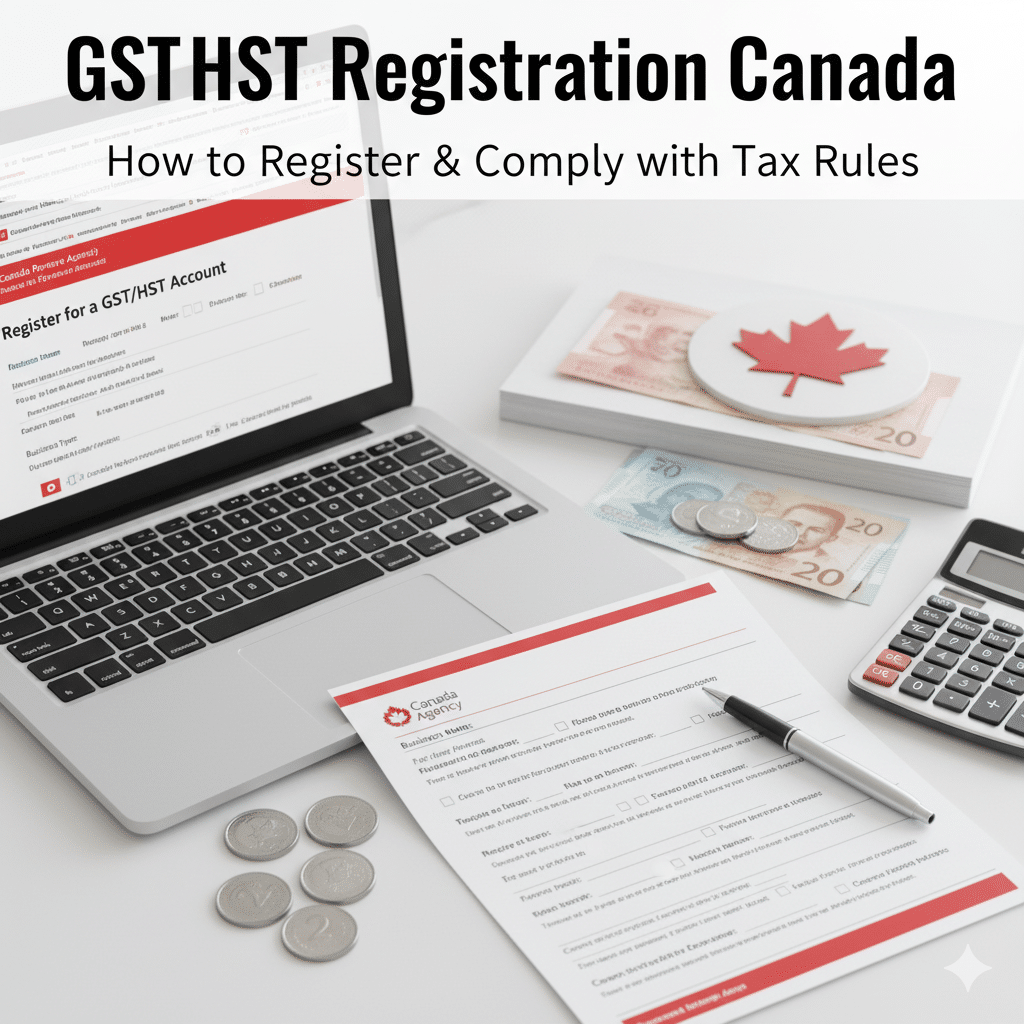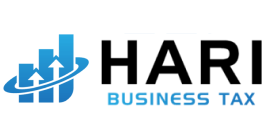GST/HST Registration Canada: How to Register & Comply with Tax Rules
GST/HST Registration Canada is essential for businesses looking to comply with tax regulations, and Gondaliya CPA offers a simple guide to help you understand GST/HST for businesses and how to register for the GST/HST quickly. This post covers key steps on how do I register to collect GST/HST, including specifics for digital economy business.
Request a Free Consultation
Understanding GST/HST
Goods and Services Tax (GST) and Harmonized Sales Tax (HST) make up Canada’s federal sales tax system. GST applies to most goods and services sold across Canada. HST mixes the provincial sales tax with GST in certain provinces. Canadian businesses must follow these tax rules to avoid fines and keep their operations smooth.

- GST is a value-added tax.
- HST combines provincial sales tax with GST.
- Compliance helps businesses avoid penalties.
What is GST/HST?
Businesses need to know about GST/HST because it affects their taxes in Canada. The Canada Revenue Agency (CRA) manages these taxes. They make sure businesses collect and pay GST or HST on taxable goods and services.
- Businesses charge GST or HST unless exempt.
- Charging these taxes keeps business legal.
- Businesses can claim Input Tax Credits (ITCs) to lower taxes.
This system helps businesses reduce their tax load by claiming ITCs on purchases related to their business.
Mandatory vs. Voluntary Registration
You might have to register for GST/HST either because you must, or because you want to:
- Mandatory Registration: Required if your business passes the small supplier threshold.
- Voluntary Registration: You can register even if your revenue is below the limit, which helps you claim ITCs.
Knowing if registration is mandatory or voluntary makes managing your taxes easier.
The “Small Supplier” Rule: Calculating the $30,000 Threshold
The small supplier rule says you only have to register once your taxable revenue goes over $30,000. This is counted over one calendar quarter or four quarters in a row.
Here’s what you should know:
- Count all taxable income worldwide before expenses.
- Some workers like taxi drivers and ride-share drivers must register right away no matter what.
- If your taxable revenue goes past $30,000 at any time during a quarter, you must register from that day on.
Tracking your revenue against this $30,000 limit helps avoid fines and keeps you compliant with Canadian tax rules.
Understanding these parts of GST/HST registration helps Canadian small business owners like you make smart choices about taxes. You can also get help from pros like Gondaliya CPA for cash flow advice and tax planning when needed.
Registering for GST/HST in Canada
Registering for GST (Goods and Services Tax) or HST (Harmonized Sales Tax) is a must for many Canadian businesses. It works under the federal sales tax system. You’ll need to register depending on what your business does and how much money it makes. The GST/HST registration process means getting a Business Number (BN) from the Canada Revenue Agency (CRA). Then, you add a GST/HST account to that number.
You can easily register GST online through CRA’s Business Registration Online service. It lets you send your application, talk to CRA, and manage your account all without paperwork or long waits.
If you do business in Quebec, things change a bit. That’s because Revenu Québec handles QST (Quebec Sales Tax). So, you’ll also have to do separate Revenu Québec registration for QST.
Crossing the Threshold: Mandatory Registration
Canadian businesses must follow rules about mandatory GST registration once they earn above certain amounts. This is called the “Small Supplier” threshold:
- If your total worldwide taxable supplies go over $30,000 before expenses during either one calendar quarter or four straight quarters, you must register for GST/HST right away.
- Taxi or ride-sharing drivers don’t get a break. They have no threshold and must register no matter what they earn.
- When you go over the limit, you must charge GST/HST on all taxable sales from that day on. Not doing this can cause CRA to fine you or charge interest.
This rule helps keep Canada’s federal sales tax fair while giving smaller businesses some breathing room at first.
Benefits of Voluntary Registration
You don’t have to register if your business makes less than $30,000. But sometimes it’s smart to register anyway:
- You can claim Input Tax Credits (ITCs) on things like office gear or startup costs.
- ITCs help you get back GST/HST paid on business buys.
- Voluntary registration also makes you look more legit to suppliers and customers who want registered vendors.
Even if you register voluntarily, you still file returns like everyone else. But it can help with cash flow by letting you claim more ITCs.
It’s worth thinking about voluntary registration when the taxes paid on inputs beat the cost of following rules—especially if your business is growing but not yet hitting the mandatory limit.
Taxable vs. Exempt vs. Zero-Rated Supplies
Knowing which supplies count how helps with registration and taxes:
| Supply Type | What It Means | Examples | What It Means For You |
|---|---|---|---|
| Taxable Supplies | Goods/services charged standard GST/HST | Most products and services | Must charge tax; can claim ITCs |
| Exempt Supplies | Goods/services not taxed at all | Financial stuff, health care | Don’t charge tax; no ITCs allowed |
| Zero-Rated Supplies | Goods taxed at 0% but still taxable | Basic food, prescription meds | Charge 0%; can still claim ITCs |
If your business sells only exempt stuff, you cannot register or claim input credits because no tax applies.
Getting these differences right helps avoid wrong charges and keeps things smooth with Canada’s federal sales tax system.
The Registration Process
Here’s how to sign up for GST/HST:
- Get a Business Number (BN) from CRA if you don’t have one.
- Apply online using Business Registration Online or call/mail CRA asking for a GST/HST account linked to your BN.
- Give info like your legal name, address, fiscal year-end date, estimated revenues.
- Wait for confirmation with the registration effective date—usually when you cross the small supplier threshold or choose voluntary sign-up.
- Use CRA’s My Business Account portal to file returns every reporting period—even if some sales are zero-rated.
This simple process helps keep your business on track with taxes and makes updates easy when things change in your business or location.
Registering in Quebec: Revenu Québec Differences
If you work in Quebec plus other provinces covered federally:
- You must register separately with Revenu Québec for QST collection even after getting federal BN/GST accounts.
- Most provinces use combined HST rates handled by CRA accounts.
- Quebec runs its own provincial sales tax through Revenu Québec with different filing and payment schedules.
Knowing these differences stops mix-ups between two similar but separate systems important for Canadian businesses’ taxes under both sets of rules.
Managing Your GST/HST Obligations
If you run a small business in Canada, handling your GST/HST obligations is really important. Once you sign up, you’ll get a GST/HST account tied to your Business Number (BN) Canada. This account keeps track of all the tax reporting for GST/HST.
You have to file GST/HST returns regularly. These returns show how much tax you collected and paid. You might file every month, quarter, or year. It depends on how big your business is and what CRA wants. Sending these returns on time helps you avoid trouble with the tax folks.
- Register and get your GST/HST account
- Report taxes through regular GST/HST filing
- Submit returns on time to stay in good standing
Charging and Collecting GST/HST
If you sell taxable goods or services and are registered, you must charge GST/HST on those sales. That means adding the right tax amount based on where your customer lives.
Once registered, collecting this tax isn’t a choice—you act like a middleman for the government. You need to keep track of all the taxes you collect until you send them off.
If you don’t register when you should, you might miss charging customers the right way or get fined for not collecting enough tax.
- Charge GST/HST on taxable supplies
- Register to collect before starting sales
- Keep records of taxes charged and collected
Filing GST/HST Returns
Filing a GST/HST return means telling CRA:
- How much sales had GST/HST
- The total tax you collected
- Any Input Tax Credits (ITCs) you want to claim
Knowing this helps figure out if you owe money or should get a refund.
To make filing easier:
- Keep good records all year long
- Use software that works with CRA’s system
- Pick a filing schedule that fits your cash flow
CRA has online tools that let you submit your returns fast and safe.
Remitting GST/HST Payments
After filing, if you owe money, you have to send it by the deadline. This is called remitting GST/HST payments. Deadlines depend on whether you report monthly, quarterly, or yearly.
Sending payments late can cause interest and penalties. So, set reminders so you don’t forget.
For many small businesses, paying quarterly fits best because payments aren’t too big but happen often enough.
- Pay owed amounts by due dates
- Avoid extra charges with timely remittance
- Quarterly payments balance cash flow
Claiming Input Tax Credits (ITCs)
One reason to register for GST/HST—even if optional—is to claim input tax credits (ITCs) in Canada. ITCs let businesses get back the GST or HST paid on things like office supplies, gear, rent, utilities, and starting costs.
To get the most from ITC claims:
- Save all receipts showing tax paid
- Make sure expenses are for your business only
- Keep personal costs separate from business ones
Claiming ITCs lowers the total tax owed by subtracting what you’ve already spent from what you’ve charged customers. This helps with managing money better over time.
Knowing how to handle your registration—from charging correctly to filing and paying on time—keeps things running smoothly while following Canadian law.
GST/HST for Digital Economy Businesses
Canadian tax rules now cover many digital economy businesses. This includes those selling digital products or services online. If you sell software, e-books, streaming services, or other digital goods to people in Canada, you need to know how GST/HST works.
Non-resident businesses that sell digital products to Canadians usually have to register for GST/HST in Canada. This also covers platform-based accommodation providers, like short-term rental hosts who use online marketplaces. The government makes these platforms and non-resident sellers collect and send GST/HST on sales made in Canada.
You can pay GST/HST using foreign currency. But you must convert those payments into Canadian dollars when figuring out the tax owed. Non-resident sellers should follow registration rules by getting a Canadian Business Number (BN) and opening a GST/HST account if their sales go over the small supplier threshold.
If you want to know more about registering as a non-resident digital business or how platform-based accommodation tax works, check official CRA guides or talk with advisors who know cross-border taxes well.
Simplified GST/HST Account
The simplified GST/HST account helps small suppliers handle their taxes easier. It’s for businesses under the $30,000 small supplier threshold. This option lowers the paperwork and lets you file less often than with a normal account.
You can also register voluntarily using a simplified account. This is good if you want to claim Input Tax Credits (ITCs) before hitting the threshold. Startups like this because they get some benefits without dealing with complex rules right away.
But if your revenue goes past $30,000 in four calendar quarters or even one quarter, you usually must switch to a normal account. Then you’ll have full filing duties.
Deciding whether to register early using a simplified account or wait depends on your business needs. Think about cash flow and how much work you want managing taxes before choosing.
Normal GST/HST Account
You need a normal GST/HST account when your taxable sales go over $30,000 yearly. To get one, register for a Business Number (BN) from the Canada Revenue Agency (CRA).
After registering:
- You must charge the correct GST or HST on taxable sales.
- File returns regularly — monthly, quarterly, or yearly — based on your income.
- Keep clear records of taxes collected and paid.
This setup keeps you legal but means more work like filing on time even when no sales happen.
If your business is in Quebec, follow similar steps but register separately with Revenu Québec for QST along with federal registration where needed.
Registration Requirements and Options
In Canada, any business expecting total worldwide taxable supplies over $30,000 during four calendar quarters must register for GST/HST right after crossing that limit. This rule applies even if some sales happen outside Canada but relate directly to Canadian customers.
Once registered, you can legally collect tax from buyers starting the day your sales exceed the threshold. Not registering can cause fines and interest charges from CRA enforcement.
| Requirement | Details |
|---|---|
| Small Supplier Threshold | $30K total worldwide taxable supplies over 4 consecutive quarters |
| Mandatory Registration | Required immediately upon exceeding threshold |
| Voluntary Registration | Allowed below threshold mainly for ITC claims |
| Must Charge & Collect | Once registered |
| Business Number (BN) | Needed before collecting/filing |
Knowing these options helps keep you compliant while managing cash flow better—a key area supported by experts like Gondaliya CPA who focus on tax planning advice.
Keywords:
- GST/HST on digital products · Non-resident digital economy GST · Platform-based accommodation tax · Non-resident GST/HST registration · Foreign currency GST payments · Canadian sales tax registration · Simplified GST/HST account · Small supplier threshold · Voluntary GST registration · Administrative burden · Normal gst/hst account setup · Mandatory gst registration canada · Business number canada BN· Gst registration canada· Register To Collect· Exceed The Threshold· Must Charge Gst/hst
Avoiding Common Pitfalls in GST/HST Registration Canada
Responsibility to Remit Collected Tax
When you register for GST/HST, you have to charge GST/HST on all taxable sales. This means you collect tax from your customers and remit collected tax to the Canada Revenue Agency (CRA) on time. Paying the tax late can cause trouble, like penalties or interest.
Once your business passes the small supplier limit or you decide to register, you must charge GST/HST properly. If you don’t remit collected tax, CRA might audit your business and fines could follow. Even if a customer hasn’t paid yet, you still owe the tax amount.
Here are some tips to stay on track:
- Calculate GST/HST using the right rates.
- Keep good records of sales and taxes.
- Pay by CRA deadlines. These might be monthly, quarterly, or yearly.
Knowing this responsibility helps avoid big mistakes that new businesses often make.
Administrative Burden of Filing Returns
Registering for GST/HST means filing regular returns with CRA. The administrative burden includes making sure your reports are correct. You must file even if you had no sales during a period. The return shows taxes collected and any input tax credits.
Filing a GST/HST return needs care but it can be easier with online tools. If your yearly taxable supplies go over $1 million, CRA makes electronic filing required. Filing electronically cuts down errors and speeds up processing.
Try these tips to reduce hassle:
- Set up reminders for filing dates.
- Use accounting software that works with CRA.
- Stay organized all year long.
Using GST/HST electronic filing saves time and helps your business keep up without stress.
Avoid these common mistakes to keep your GST/HST registration smooth. Paying your taxes when due and filing returns properly protects your business from fines. It also lets you claim input tax credits without trouble.
Frequently Asked Questions on GST/HST Registration Canada
What is a GST/HST rebate, and how can my business claim it?
A GST/HST rebate lets your business recover some tax paid on expenses. You claim it by filing the appropriate forms with CRA during your return.
How do I apply for a Business Number (BN) in Canada?
You apply online through CRA’s Business Registration Online service or by phone. The BN is essential for GST/HST accounts.
What security measures protect my GST/HST account?
CRA uses strict protocols. Businesses should keep their account info confidential and use secure online portals for transactions.
When are GST instalments required?
CRA requires instalments if your net tax owing exceeds a certain threshold. Instalments help spread out your tax payments throughout the year.
How can I authorize someone to manage my GST/HST account?
Use form AUT-01 to grant representative authorization. This lets an accountant or advisor handle your tax matters with CRA.
Where are the nearest Tax Services Offices (TSO)?
You can find TSOs listed on CRA’s website. These offices provide in-person assistance and resources.
What should non-resident businesses know about GST/HST registration?
Non-residents selling taxable goods or digital services in Canada must register once they cross the $30,000 threshold. They also follow remittance and reporting rules.
Do sole proprietors have different GST/HST registration rules?
No, sole proprietors follow the same rules as corporations but report income differently on tax returns.
What are recent GST/HST new rules affecting businesses?
Changes include stricter compliance for digital sales and platform-based rentals, plus updated remittance options including foreign currency payments.
How does the GST/HST payment schedule work?
Payments depend on your reporting period—monthly, quarterly, or annually. CRA sets deadlines for each period to ensure timely remittance.
Additional Key Points on GST/HST Registration Canada
- GST/HST number: Your unique identifier linked to your Business Number used for all tax-related activities.
- GST instalments: Periodic payments made when annual taxes exceed CRA’s threshold. Helps avoid lump sum payments.
- Authorized representative form AUT-01: Grants authority to someone else to interact with CRA about your account.
- Foreign currency GST payments: Non-residents may pay in foreign currency but must convert to Canadian dollars for reporting purposes.
- GST/HST security deposit: CRA may require deposits from non-resident registrants as a compliance guarantee.
- Tax credit exemptions: Certain organizations qualify for exemptions; understand eligibility criteria carefully.
- Business taxable revenue: All taxable sales worldwide count towards your small supplier threshold.
- GST/HST registration support: Professional services like Gondaliya CPA can help simplify the process and maintain compliance.
- Tax authority communication: Regular contact with CRA or Revenu Québec ensures smooth account management and quick issue resolution.
- Manage account online: Use CRA’s My Business Account portal to update details, file returns, and track payments securely.
- Submit returns: File accurate returns regularly regardless of sales volume to stay compliant and claim credits promptly.
- Ensure compliance: Follow all deadlines and reporting rules to avoid penalties and interest charges from CRA.
- Streamline filing: Automate accounting processes with compatible software that integrates with CRA systems for easy reporting.
- Recover GST paid: Claim Input Tax Credits (ITCs) properly by keeping receipts for deductible expenses related to business activities.
- Deductible expenses: Include office equipment, rent, utilities, and startup costs that qualify under ITC claims in your filings.
- Business activities: Regularly review if your operations require changes in registration status or filing frequency with CRA.
- Timely remittance: Set reminders to send payments before deadlines; late remittance incurs penalties that hurt cash flow.
- Clear understanding: Stay informed about current Canadian tax regulations and how federal sales tax applies to your business model.
- Step-by-step guide: Follow detailed instructions from trusted sources or professionals to complete each stage of registration correctly.
- Simplify business compliance: Use expert advice and technology tools to reduce errors and administrative burdens linked to tax filings.
- Maximize tax benefits: Optimize ITC claims and rebates legally by maintaining accurate records and following best practices recommended by experts.
- Accurate records: Keep organized files of all financial transactions including sales invoices, receipts, and banking statements related to GST/HST activities.
- Secure tax management: Protect access credentials, use official channels for communication with tax authorities, and monitor accounts regularly for discrepancies.
How Gondaliya CPA Can Help with GST/HST Registration Canada

Handling GST/HST registration in Canada can feel tricky, especially for small businesses. Gondaliya CPA steps in to help you stay on the right side of Canadian tax legislation. We also help you get the most from your money where we can.
Here’s what we cover:
- Sorting out your compliance responsibility
- Giving professional advice
- Keeping your business compliant
- Talking to tax authorities for you
Determining Registration Eligibility
Knowing if you have to register for GST/HST is super important. Gondaliya CPA checks if you need to register because of mandatory GST registration rules. Or maybe voluntary GST registration fits better for your case.
We look at your total taxable supplies worldwide and see if you go past the $30,000 small supplier threshold. If you do, then the GST/HST registration threshold kicks in and you need to act.
If your sales cross that limit, we help you take the right steps fast. That way, you avoid penalties or late fees.
Here’s how we help figure this out:
- Check your yearly taxable supplies
- Compare with $30,000 small supplier threshold
- Decide on mandatory or voluntary GST registration
- Guide when thresholds are exceeded
Managing the Registration Process
Getting registered means getting a Business Number (BN) from the Canada Revenue Agency (CRA). You also have to set up a CRA business account.
This stuff can be confusing, but Gondaliya CPA helps with:
- Registering GST online
- Submitting your application right
- Using Business Registration Online tools
We make sure everything is done properly and on time. This means your effective date matches what CRA requires.
Handling GST/HST Reporting and Compliance
After registration, you have to file GST/HST returns regularly. You also must send payments on time based on your reporting period. Reporting could be monthly, quarterly, or annually depending on your setup.
Gondaliya CPA handles:
- Filing GST/HST return for you
- Making sure remitting GST/HST payments happens on time
- Dealing with reporting periods so nothing gets missed
If needed, we communicate with CRA or Revenu Québec too. This takes pressure off you and keeps everything neat and tidy.
Maximizing ITC Claims
One reason some businesses sign up voluntarily is to claim input tax credits (ITCs). These let you get back GST/HST paid on things like office gear or startup costs.
We help by:
- Identifying input tax credits Canada that apply to you
- Showing how to claim input tax credits properly
- Helping maximize ITC claims so more money comes back
Working with Gondaliya CPA helps keep your business within Canadian tax laws without extra stress. We’re here every step—from deciding if you need to register all the way through ongoing reporting. This way, small businesses handle GST/HST registration Canada challenges without confusion or delay.

Sharad Gondaliya CPA Canada and CPA USA having 14 Years+ experience of Accounting, Tax, Payroll of Corporate Small Businesses as Tax Accountant. He is fully certified CPA Ontario and CPA USA. He is well known amoung Corporate Small Businesses for Tax Planning, efficient Tax solutions and for Affordable CPA services, He is Principal (Director) at Gondaliya CPA – Affordable CPA in Canada.




